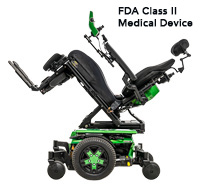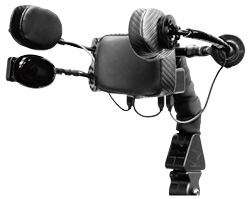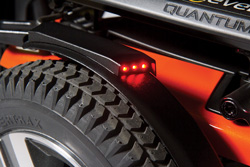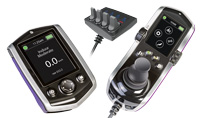Meeting the needs of people living with Spinal Cord Injuries
Condition
Spinal Cord Injury (SCI) is damage to the spinal cord that results in loss of function such as mobility or sensation. An SCI may result from trauma, tumor, ischemia, a developmental birth defect (such as spina bifida), transverse myelitis or vascular malformations.
There are two main classifications of spinal cord injuries, complete and incomplete. A complete injury means there is no voluntary movement or sensation below the level of the injury. An incomplete injury means that the ability of the spinal cord to convey messages to or from the brain is not completely lost. Additionally, some sensation (even if it’s faint) and movement is possible below the level of injury.

Mobility and Assistive Technology Needs



Depending on the level of the injury, some individuals may only require the use of a walker or braces to accomplish independent mobility.
A large percentage of those with an SCI rely on the use of power mobility to live independently or achieve independent mobility in their environment. Some individuals will require the assistance of a ventilator to aid with breathing.
If a power mobility device is required, it is suggested the client be evaluated during rehabilitation in order to promote increased independence, improve confidence in his/her mobility and to achieve as high a level of independence as possible with the power mobility device.
The client should be fitted with a power base that can meet various seating, positioning and electronics needs. Clients with a high level of injury will require a power positioning system to provide them with the ability to perform independent pressure relief, changes in positioning and gravity assisted positioning. Power seating options for this group of individuals are power tilt, power recline, and power tilt and recline. Additional options are a power adjustable seat lift, power articulating leg rests and a power articulating foot platform.
A customized seating system is an important part of helping a client compensate for weakness or lack of muscle control and providing proper support and pressure distribution for the prevention of pressure ulcer development. There are also many custom accessories that can be added to the seating system in order to maximize the individual’s independence with Mobility Related Activities of Daily Living (MRADLs). Optional LED fender lights on the Edge® 3, Edge 3 Stretto™ and Q6 Edge® Z (optional on the Q6 Edge® 2.0 and Q6 Edge® HD) help clients see and be seen.
Often, a client’s needs and abilities will change over time due to gravity’s effect on the body (years or months). A modular seating system should be considered to accommodate these changes. Also, for this reason, periodic evaluation of the client should be performed to prevent orthopedic deformity from occurring.
The Quantum® Solution


Clients with SCI who have significant mobility needs due to the level of injury will benefit from a power base that has the ability to accept full seating and positioning options like power tilt, recline, and power tilt and recline. This offers a client with decreased ability to shift weight with independent pressure relief and allows the individual to maintain healthy skin integrity at the tissue surfaces making contact with the seat cushion.
The Edge® 3 and Edge 3 Stretto™ are designed to meet client needs by accepting a full range of seating, positioning and electronic options. Every other power chair is at least 2.5” wider than the Edge 3 Stretto! Optional iLevel® Power Adjustable Seat Height at up to 4.5 mph lifts clients up to 12”, promoting greater social interaction and independence.
The Q6 Series also accepts a selection of seating and positioning options, and possesses a proven track record of quality, reliability and customer satisfaction All chairs in this series have the capability to accept expandable electronics that meet the changing needs of your client.
TRU-Balance® 3 Power Tilt, Power Recline, and 12” Power Adjustable Seat Lift with iLevel® provide clients with dynamic seating essential for positioning, comfort, skin integrity and function within the seating system. iLevel has up to 12” of lift that can be beneficial to your client during transfers and help to maintain independence in a variety of environments. iLevel can also potentially assist your SCI client with easier transfers to examination tables for medical appointments, which is a critical part of care for an individual living with an SCI. TRU-Comfort 2 Seating provides excellent comfort and pressure management in addition to having an aesthetically pleasing look. Stealth Products® Cushions allow for added stability and support for a client’s positioning and provide exceptional envelopment to assist with pressure management.
Q-Logic 3 Advanced Drive Controls are user-friendly and highly customizable. The Q-Logic 3 EX Joystick comes standard with wireless Bluetooth programming through Windows devices and Bluetooth access to computer, tablet and phone functions. Clinic Mode allows for quick setup of multiple input devices during client evaluations and automatically assigns drive modes to input devices. The Q-Logic 3 iAccess features programmable push button and toggle options for customized seating access.
The < ahref="https://www.quantumrehab.com/quantum-electronics/q-logic-3-advanced-drive-control-system-options.asp">Q-Logic 3 EX Enhanced Display includes a learning IR and wireless Bluetooth options. Since some clients with SCI may have trouble communicating, the Enhanced Display is equipped with a Bluetooth mouse emulator that can provide wireless access with wheelchair controls to a communication device to enhance your client’s communication with others. In addition, the Bluetooth feature also provides your pediatric clients with independent control of a computer mouse through their electronics so they can participate at a higher independent level with school work. The Enhanced Display also has the ability to learn infrared commands for your client to control devices like televisions and X10 technology to further improve independence.
Stealth® i-Drive®
The i-Drive® is the most advanced wheelchair drive control in the world. The drive control works at a frequency of 16kHz, which provides real time user interface and results in improved driving efficiency, better feedback, smoother control and a more intuitive “feel.” Our superior positioning and head control products produce a mechanical framework for the i-Drive technology that offers limitless combinations of head, trunk and cervical positioning options.
| Level | Implications | Equipment to Consider |
|---|---|---|
| C1-C3 | Poor head control, weak neck muscles, respiratory problems | Power wheelchair, alternative drive controls, power positioning system, pressure managing seat cushion, solid backrest support, trunk and extremity supports, ventilator |
| C4 | Good head control, can shrug shoulders, no upper extremity function, possible respiratory problems | Power wheelchair, alternative drive control, power positioning system, vent tray, pressure managing seat cushion, solid backrest support, trunk and extremity supports, ventilator |
| C5 | Good shoulder abduction and extension, elbow flexion | Power wheelchair, possible alternative drive controls, modified joystick handle, power positioning system, pressure managing seat cushion, solid backrest support, trunk support, ultra-lightweight manual wheelchair with handrim projections |
| C6 | Good shoulder function, radial wrist extension, strong elbow flexion | Power wheelchair, modified joystick handle, power positioning system, pressure managing seat cushion, solid backrest support, trunk support, ultra-lightweight manual wheelchair with handrim projections or coated handrims |
| C7 | Good elbow extension, good wrist function, minimal grasp | Power wheelchair, modified joystick handle, power positioning system, pressure managing seat cushion, solid backrest support, trunk support, ultra-lightweight manual wheelchair with coated handrims |
| C8 | Good elbow extension, good grasp with minimal dexterity | Power wheelchair, possibly modified joystick handle, power positioning, pressure managing seat cushion, solid backrest support, trunk support, ultra-lightweight manual wheelchair possibly with coated handrims |
| T1 | Full hand dexterity | Power wheelchair, power positioning system, pressure managing seat cushion, solid backrest support, trunk support, ultra-lightweight manual wheelchair |
| T2-T7 | Chest muscles, no abdominal muscles | Power wheelchair, ultra-lightweight manual wheelchair, pressure managing seat cushion, solid mid-height backrest, possible lateral trunk supports |
| T8-T10 | Upper abdominal muscles | Ultra-lightweight manual wheelchair unless other medical diagnoses call for a power wheelchair, pressure managing seat cushion, mid-height solid backrest support |
| T10-T12 | Lower abdominal muscles | Ultra-lightweight manual wheelchair, pressure managing seat cushion, low solid backrest support |
| L2 | Hip flexors | Ultra-lightweight manual wheelchair, pressure managing seat cushion, low solid backrest support |
| L3 | Knee extensors | Ultra-lightweight manual wheelchair, pressure managing seat cushion, low solid backrest support |
| L4 | Ankle dorsiflexion | Ultra-lightweight manual wheelchair, pressure managing seat cushion, low solid backrest support |
| L5 | Toe extension | Ultra-lightweight manual wheelchair, pressure managing seat cushion, low solid backrest support |
| S1 | Ankle plantarflexion | Ultra-lightweight manual wheelchair, pressure managing seat cushion, low solid backrest support |


